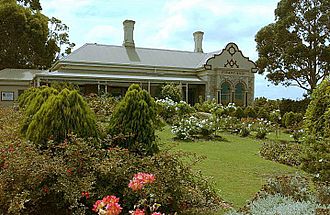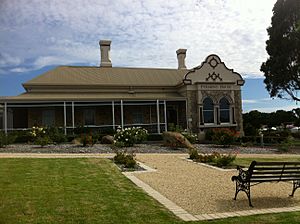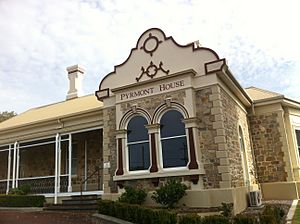Pyrmont, Albany facts for kids
Quick facts for kids Pyrmont |
|
|---|---|
 |
|
| Former names | Pyrmont House, Great Southern Development Commission |
| General information | |
| Architectural style | Cape Dutch style |
| Address | 110 Serpentine Road |
| Town or city | Albany |
| Coordinates | 35°01′18″S 117°52′55″E / 35.0216°S 117.8820°E |
| Completed | 1858 |
| Type | State Registered Place |
| Designated | 30 August 2002 |
| Reference no. | 44 |
| References | |
| Heritage Council of Western Australia | |
Pyrmont, also known as Pyrmont House, is a very old building in Albany, Western Australia. It is located on Serpentine Road. This building is one of the oldest in the city of Albany.
Contents
What Pyrmont House Looks Like
Pyrmont House is built from strong granite stone. It has nine bedrooms inside. There are also other smaller buildings on the property. The front of the house has special parts that stick out. These parts have unique curved gables and bay windows. The roof is made of corrugated iron. It also has decorative chimneys made of brick.
The house has a nice verandah around it. It sits on a large, well-kept garden. The garden covers about 3,400 square meters. The design of Pyrmont House is based on the Cape Dutch Colonial style. This style comes from South Africa.
History of Pyrmont House
When Pyrmont House Was Built
Pyrmont House was built in 1858. It got its name from a small area in Prussia called Pyrmont. This was where Princess Helena of Waldeck and Pyrmont was from. She was married to Prince Leopold, Duke of Albany.
Early Owners and Uses
The house was first built for Thomas Meadows Gillam. He was a local businessman. He also worked for the P&O Shipping line. Later, his son William lived in the house.
In 1887, Robert Andrew Muir bought the property. He later became the Mayor of Albany. A mayor is a leader of a city or town.
By 1898, Pyrmont House was used as a school. Ms McPherson was the principal, or head teacher, of this school. In 1904, it became a place for a dress-making business. Later that same year, the house was put up for sale.
Changes Over the Years
George Hill bought the property in 1911. He paid about £2000 for it. Just 24 hours later, he sold most of it to Edward Barnett. Hill kept a small part of the land for future building.
After Edward Barnett passed away in 1952, the house was sold again. In 1953, the Country Women's Association (CWA) bought it. The CWA opened Pyrmont as a club for their members in 1954. They also bought the land next to it. This land used to have tennis courts. The CWA built their own hall there.
During this time, Pyrmont House was used as a place for young teachers to live. The gardens were a play area for primary school children. By 1966, the CWA found it too expensive to keep the house. So, they sold Pyrmont to Barnesby Motors, a car dealership. The dealership used it to store car parts.
Saving Pyrmont House
More than ten years later, the building was in very bad condition. People even talked about tearing it down. But the community did not want that to happen. They worked to save the building. In 1981, Robert and Lucy Winlow bought Pyrmont House. They worked hard to fix it up and make it new again.
In 1994, Nilla and John Spark turned the restored building into a place for events and a restaurant.
Heritage Recognition
The National Trust officially recognized Pyrmont House in 1977. This means they saw it as an important historical building. In 2002, it was added to the State Register of Heritage Places. This is a list of important historical sites in Western Australia.
Today, the Great Southern Development Commission has offices in the building. They have 13 staff members working there.
Images for kids




